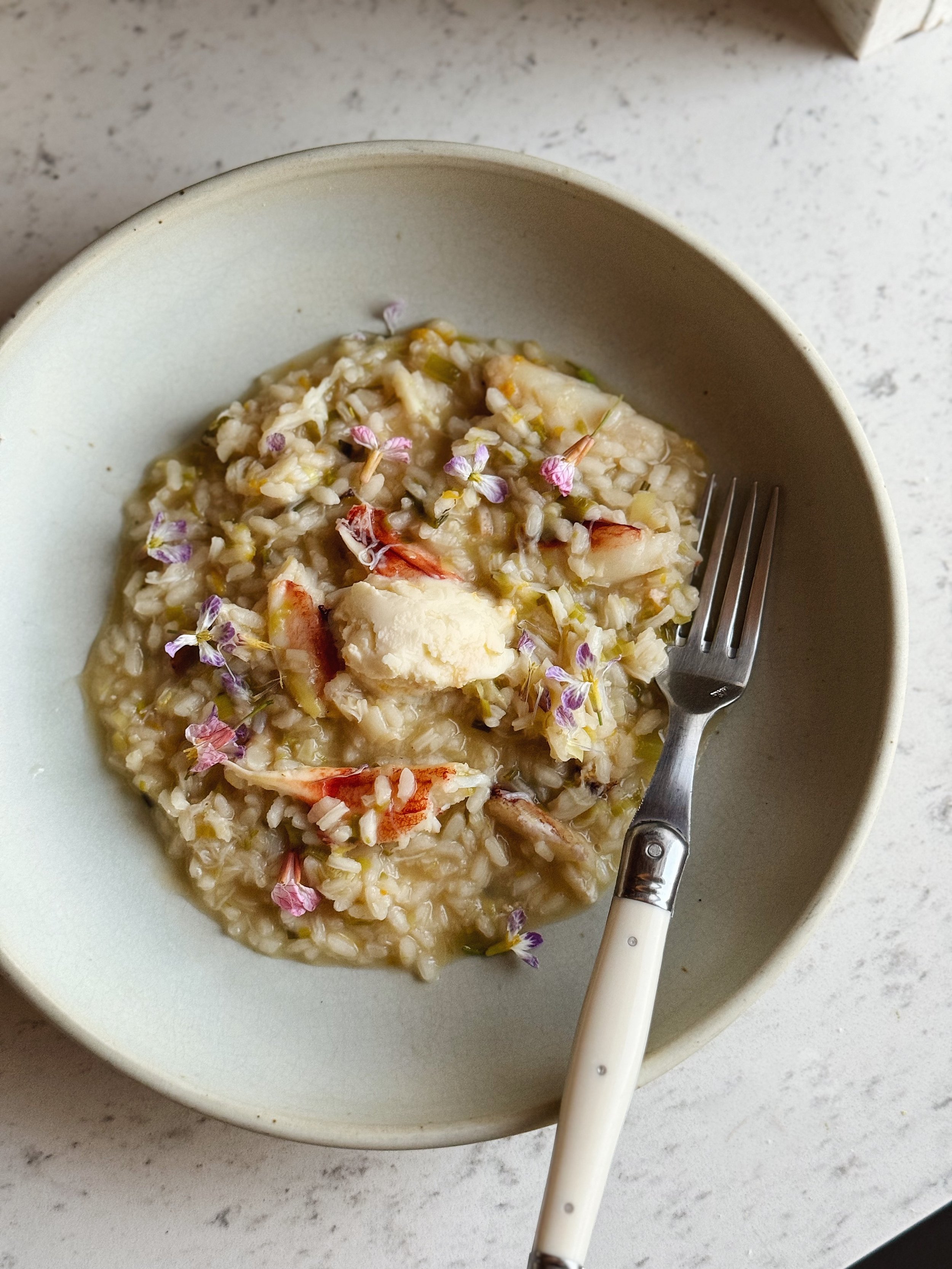Spring Crab Risotto with Lemony Mascarpone
I’m not sure what it is but every time spring hits, I develop a new risotto recipe (evidence here from 2022 and here from 2023). I’m honestly not mad about it though, because risotto is one of my absolute favorite things to cook and one of the most delicious, comforting things to eat.
This crab version is perfect because we’re in the thick of Dungeness Crab season in the Bay Area. I marry that fresh crab meat with a bunch of bright, springy flavors, including green garlic and lemon and I top the whole thing off with a lemon zest infused mascarpone that adds the perfect creamy richness to the dish.
I hope you give it a try and love it as much as we do in our house!
Serves 6-8
INGREDIENTS
1/2 cup mascarpone cheese
Kosher salt
Zest from 3 meyer lemons, divided
Juice of 1 meyer lemon
2 quarts stock (I used vegetable here but parmesan or seafood would be delicious here too)
6 Tbsp butter, divided (can use salted or unsalted)
2 medium shallots, minced
2 stocks green garlic (white part only) or 2 scallions (white part only), minced
2 cups Arborio or Carnaroli rice
1/2 cup dry white wine (I like to use Sauvignon Blanc)
1 cup freshly grated Parmesan cheese + more to finish
1 lb crab meat*
Freshly ground pepper
Fresh herbs, edible flowers and extra virgin olive oil to finish (optional)
METHOD
Mix together the mascarpone with a pinch of kosher salt and the zest of 2 of the lemons, reserving the remaining zest for later. Slowly add in the lemon juice until you reach your desired consistency - easy to whip but not too loose. Transfer to the refrigerator while you make the risotto.
Bring the stock up to a simmer in a large pot on the back burner. Turn off the heat and cover to keep warm.
Meanwhile, heat a large saute pan over medium-low heat and add 4 Tbsp of the butter. Once the butter is melted, add the shallot, green garlic and a generous pinch of kosher salt. Cook until onions and garlic are soft but not brown, 3-4 minutes, stirring occasionally.
Add the rice to the softened shallow/green garlic mixture. Stir to coat the rice with the butter and cook for 2-3 minutes until the rice has turned opaque. You don’t want to brown the rice, so turn down the heat, if necessary.
Add the wine and stir. Once the rice has absorbed the wine, add a ladle-full (about 1 cup) of the warm stock. Stir often, but not constantly (every minute or so). The heat should be medium-low at this point. You want the liquid to be gently simmering. Once the majority of the stock has been absorbed by the rice, add another ladle-full of stock.
Continue this process – adding a ladle of stock, stirring often but not constantly, and waiting for the rice to almost completely absorb each addition of stock before adding the next. Do this until all of the warm stock has been added and absorbed and the rice is cooked to al dente (has a little bit of a bite to it). This will take 20-30 minutes. See the notes section below for what the final product should look like!
Turn off the heat and stir in the grated Parmesan cheese, remaining 2 Tbsp butter, remaining lemon zest and the crab meat. Add kosher salt, to taste.
Serve in bowls topped with a dollop of the reserved lemony mascarpone and optional fresh herbs or edible flowers and a drizzle of olive oil. Enjoy!
NOTES
Your local butcher or meat counter should sell containers of crab meat (removed from the shell). If you live in SF, I got some at Marina Meats in the Marina!
I add this to all of the risotto recipes I share — here are some tips we learned about risotto in culinary school. I think these nuggets are super valuable and they help you achieve restaurant-quality risotto at home!
Butter – risotto is a traditional Northern Italian dish and Northern Italy is green and lush, which makes it a prime place for cattle + livestock to live. Because of this, they have more access to milk (and butter), so Northern Italian dishes traditionally use butter as the fat. This is why a traditional risotto is made with butter instead of olive oil. You can of course use olive oil if you prefer or have it around but thought this was really interesting!
Rice – you want to use a short grain white rice for risotto. The short grain rice has a lot of starch content and it can absorb a lot of liquid. Both are key factors to a creamy, luscious risotto. The two more widely available types of short grain rice in the US are Carnaroli (my personal fav!) and Arborio.
Coating the rice in butter – it’s really important to cook the rice in the butter/softened onion mixture for a few minutes (until the rice grains are white/opaque) before adding the wine and broth. That said, you don’t want to brown the rice during this process, so adjust the heat accordingly. By coating the rice in the fat for a little bit, you’re creating a barrier of butter on the outside of the rice, which helps the rice slowly absorb the broth over the course of cooking. This slow absorption of broth is key to a creamy end product.
Stir often, not constantly – risotto is so creamy and luscious because you’re agitating the rice grains as you stir them, releasing their starches. That said, if you stir the rice excessively, it will end up too thick and gummy by the end. You want to stir the risotto every couple of minutes (to prevent sticking and uneven cooking) but you can walk away for a second in between stock additions and let it do its thing too! The end goal (for a traditional risotto) is that you want to be able to see the liquid between the grains of rice in the final product. The risotto should spill out a little when you plate it – it shouldn’t stay put in a thick glob. All that said, if your risotto ends up a little thicker, that’s totally OK – it’ll taste delicious regardless!



